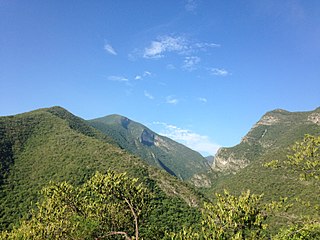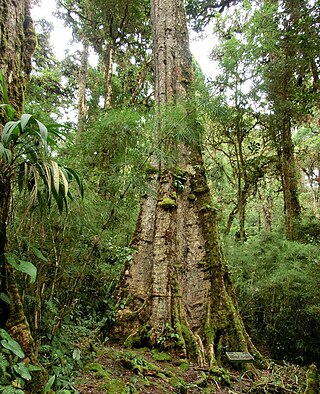
The Sierra Madre Occidental is a major mountain range system of the North American Cordillera, that runs northwest–southeast through northwestern and western Mexico, and along the Gulf of California. The Sierra Madre is part of the American Cordillera, a chain of mountain ranges (cordillera) that consists of an almost continuous sequence of mountain ranges that form the western 'sounds' of North America, Central America, South America, and West Antarctica.

The Sierra Madre Oriental is a mountain range in northeastern Mexico. The Sierra Madre Oriental is part of the American Cordillera, a chain of mountain ranges (cordillera) that consists of an almost continuous sequence of mountain ranges that form the western "backbone" of North America, Central America, South America, and Antarctica.

The Sierra Madre Occidental pine–oak forests are a Temperate broadleaf and mixed forests ecoregion of the Sierra Madre Occidental range from the southwest USA region to the western part of Mexico. They are home to a large number of endemic plants and important habitat for wildlife.
Quercus conzattii is an oak endemic to Mexico. It is placed in Quercus section Lobatae.

The Trans-Mexican Volcanic Belt pine–oak forests is a subtropical coniferous forest ecoregion of the Trans-Mexican Volcanic Belt of central Mexico.

Quercus polymorpha, the Mexican white oak, Monterrey oak or netleaf white oak, is a North American species of oak. It is widespread in Mexico, Guatemala, and Honduras, and known from a single population in the United States but widely planted as an ornamental.

The Sierra Madre del Sur pine–oak forests is a subtropical coniferous forest ecoregion in the Sierra Madre del Sur mountain range of southern Mexico.
Quercus chihuahuensis, the Chihuahua oak, is a species of oak in the beech family. It is native to the region from extreme western Texas west to Sonora, Mexico, and south to Zacatecas and San Luis Potosí. It grows mostly at mid elevations, from 400–2,000 metres above sea level, in forests mixed with various pines and other oaks. It is one of the dominant species of the Sierra Madre Occidental in Chihuahua and Sonora.

Quercus tarahumara is a species of tree in the beech family. It grows in the Sierra Madre Occidental in the Mexican States of Chihuahua, Sonora, Durango, and Sinaloa. Some of the populations lie within the territory occupied by the Tarahumara people, after whom the species is named. It is placed in Quercus section Lobatae.
Quercus viminea, the Sonoran oak, or Mexican willow oak, is a North American species of oak. It is native to northwestern and west-central Mexico, primarily in the Sierra Madre Occidental. The species range extends just north of the international border into Santa Cruz County in southern Arizona.

Quercus castanea is a species of oak tree. It is widespread across much of Mexico, from Sonora to Chiapas, and in Guatemala, El Salvador, and Honduras.

Quercus elliptica is a Mesoamerican species of oak tree. It is widespread across central and southern Mexico and Central America from Sinaloa and Hidalgo south as far as Nicaragua. It is classified in Quercus sect. Lobatae.
Quercus urbani, also known as Quercus urbanii, is a species of oak. It is native to western and central Mexico from Sinaloa, Durango, and Zacatecas to Oaxaca. It was previously synonymized with Quercus pennivenia, but this was restored as an independent species in 2020.

Quercus sapotifolia is a species of oak. It is native to southern and western Mexico as well as Central America. It is threatened by habitat loss.
Quercus tuberculata is a species of oak tree which is native to mountains of northeastern and northwestern Mexico. It is placed in Quercus section Quercus.
Quercus affinis is a species of oak native only to Mexico, mostly to the Sierra Madre Oriental pine-oak forests.
Quercus durifolia, commonly known as encino colorado, is a species of oak tree native to Mexico.
Quercus mcvaughii is a species of oak tree native to Mexico.
Quercus jonesii is a species of oak tree native to Mexico. It is commonly known as palo manzano. It is placed in Quercus section Lobatae.










